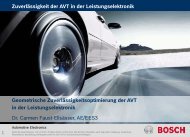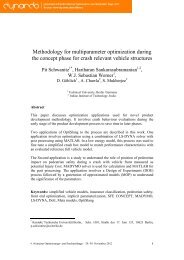multiPlas - Dynardo GmbH
multiPlas - Dynardo GmbH
multiPlas - Dynardo GmbH
Create successful ePaper yourself
Turn your PDF publications into a flip-book with our unique Google optimized e-Paper software.
1 INTRODUCTION<br />
This manual describes the use of <strong>Dynardo</strong>’s software product <strong>multiPlas</strong> for ANSYS. <strong>multiPlas</strong> is a library<br />
of elasto-plastic material models for ANSYS.<br />
The elasto-plastic material models in <strong>multiPlas</strong>, enable the user to simulate elasto-plastic effects of artificial<br />
materials, e.g. steel or concrete, and natural born materials, e.g. soil or rock, in geotechnics, civil<br />
engineering - as well as - mechanical engineering.<br />
In the context of finite element calculations with ANSYS, <strong>multiPlas</strong> provides an efficient and robust algorithm<br />
for the handling of single and multi-surface plasticity. The material models are based on elastoplastic<br />
flow functions with associated and non-associated flow rules. One special feature of the <strong>multiPlas</strong><br />
material models is the combination of isotropic and anisotropic yield conditions.<br />
The <strong>multiPlas</strong> material models are available for structural volume elements (e.g. SOLID 45, SOLID 95),<br />
for structural shell elements (e.g. SHELL 43, SHELL 93) and structural plane elements (e.g. PLANE 42,<br />
PLANE 82).<br />
The following material models and features are provided:<br />
Model Application Flow Rule<br />
isotropic Material Models:<br />
Stress-Strain<br />
Response<br />
Tresca Steel, ... associative<br />
bilinear,<br />
ideal elastic-plastic<br />
Mohr-Coulomb<br />
Soil, Rock, Stone,<br />
Masonry, ... non-associative<br />
von Mises Steel, ... associative<br />
Drucker-Prager Soil, Stone, ... associative<br />
modified<br />
Drucker-Prager<br />
Stone, Cement,<br />
Concrete, ... associative<br />
Temperature<br />
Dependency<br />
bilinear,<br />
residual strength yes<br />
bilinear,<br />
ideal elastic-plastic<br />
bilinear,<br />
ideal elastic-plastic<br />
bilinear,<br />
ideal elastic-plastic yes<br />
Concrete, Cement,<br />
nonlinear hardening<br />
Concrete Stone, Brick, ... non-associative and softening yes<br />
Tension cut off rotated cracking associative residual strength<br />
anisotropic Material Models:<br />
Joints, jointed<br />
Rock, Cohesive<br />
bilinear,<br />
Mohr-Coulomb Zones, ... non-associative residual strength<br />
Masonry_Ganz Masonry, ... non-associative<br />
Tsai / Wu Wood, ... associative<br />
boxed value Wood, ... associative<br />
Tension cut off<br />
fixed cracking,<br />
Cohesive Zones associative<br />
nonlinear hardening<br />
and softening yes<br />
bilinear,<br />
ideal elastic-plastic<br />
multilinear hardening<br />
and softening<br />
residual strength /<br />
exponential softening<br />
Additionally, all Mohr-Coulomb Models are coupled with a tension cut-off yield surface.<br />
In simulations of joint materials (e.g. jointed rock), it is possible to arrange the joint sets arbitrarily.<br />
Isotropic and anisotropic Mohr-Coulomb yield surfaces can be combined in manifold ways. Up to 4 joint<br />
sets can be associated with an isotropic strength definition.<br />
MultiPlas has been successfully applied in nonlinear simulations of and concrete as well as in stability<br />
analysis of soil or jointed rock.<br />
5<br />
USER’S MANUAL, January, 2013






